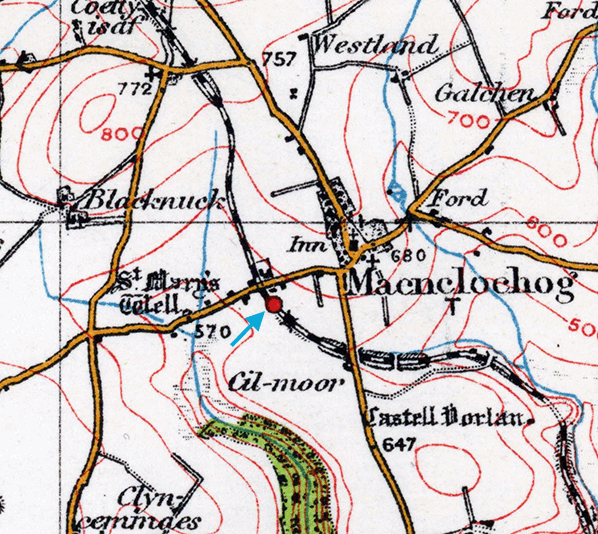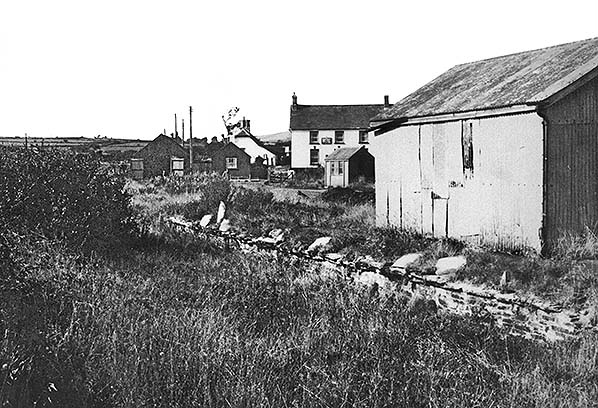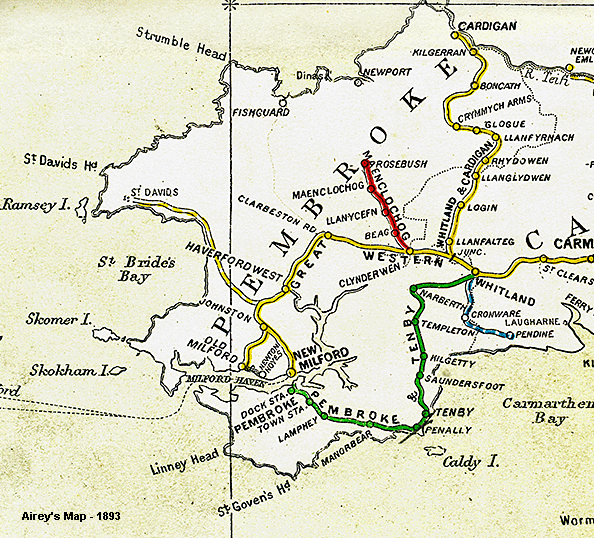
Station Name:MAENCLOCHOG
Maenclochog Station Gallery 1: 1912 - July 1974
old1.jpg) Maenclochog station looking north towards Rosebush in 1912. Measured from the village Post Office, the main part of the village is half a mile east of the station by road but, presumably owing to the coming of the railway, had spread along the road to and beyond the level crossing, seen here, over the minor road to New Moat. The station as seen here differed greatly from the original which had a single platform on the left, i.e. the down platform in this view. Maps showing the original station suggest that the original platform was a low, if not ground level, structure. Provision of a loop, up platform and its buildings dated from the extension of the line to Letterston in 1895. Pre-1895 maps show a water tank further south at the rear of the, then, platform but it is shown as a rectangular structure. The 'parachute' water tower seen in this view probably dated from 1895 but whether the original tank remained to supply it is not known, nor is it known if a similar (parachute) facility was provided on the post-1895 up platform. The original, believed McKenzie & Holland, signal box was located closer to the level crossing with that seen here being, as at Rosebush, a Dutton Type 3. Of the buildings on the up platform, the corrugated iron shed is believed to be the same, and only, structure extant as of 2017 - the corrugated sheeting may however have been replaced. Usually referred to as a goods shed, it appears to have been more of a store than goods shed in the accepted sense of the term. The goods yard was behind the up platform, to the right in this view; a siding served the shed from its other side. The walkway from the road was part of the 1895 alterations. Of the two people on the platform, that on the left is perhaps a porter or possibly the signalman. That on the right is wearing a fob watch and braided cap so will be the stationmaster. The GWR had provided new style uniforms in 1902, catapulting staff away from the styles of the early Victorian period.
Copyright photo from John Alsop collection  
1889 1:2,500 OS map shows the layout of Maenclochog station as built. The map is confusing as it does not show a platform or room for a platform with a siding shown where the platform should be. There is a complex arrangement of sidings including a loop with the entrance to the goods yard opposite the Railway Hotel where a weighbridge (WM = Weighing Machine) is shown. The Railway Hotel is one end of a terrace of four houses. The signal box is shown adjacent to the level crossing on the down side with a water tank to the south, also on the down side.
 1889 1:2,500 OS map shows the layout of Maenclochog station after the extension to Letterston was opened in 1895. The layout of the station is now more straightforward. The original platform is now shown complete with station building and adjacent goods shed. A second (down) platform with a small shelter is shown opposite. The signal box has been relocated south to the end of the down platform. The goods yard has been simplified with three sidings running behind the up platform, that to the east serving a cattle dock. A crane (C) is shown in the yard but no crane is listed for Maenclochog by the Railway Clearing House.

Maenclochog station looking north in August 1958; six years after the track was lifted. The station building has already been demolished leaving only the goods shed. In the background the weigh office is seen at the entrance to the goods yard. On the road the Railway Hotel is seen, the first building in a terrace of four houses.
Photo by Michael Hale 3.jpg)
Maenclochog station looking north-west along the platform in August 1967. The trackbed has been partially filled but part of the platform in front of the goods shed survives.
Photo by Nick Catford 1.jpg)
Maenclochog station looking south-east in August 1967. The goods shed survives in a dilapidated state but appears unused at this time.
Photo by Nick Catford 2.jpg)
Maenclochog station looking south-east along the remnant of the platform in August 1967.
Photo by Nick Catford 4.jpg) Maenclochog station looking north-west towards the level crossing in July 1974. Little has changed since the 1967 pictures; the goods shed remains in a derelict state. Maenclochog station looking north-west towards the level crossing in July 1974. Little has changed since the 1967 pictures; the goods shed remains in a derelict state.Photo by John Mann Click here for Maenclochog Station Gallery 1: July 1974 - September 2016  Home Page Home Page
|
 When the extension to Letterston opened in 1895 the station layout was radically changed. A second (up) platform was built with the original station building being replaced with a small shelter on what was now the down platform The water tank was replaced with a 'parachute' water tower the north end of the down platform adjacent to a relocated signal box south of its original position by the level crossing. The new box was a Dutton Type 3. Samuel Dutton had been an employee of McKenzie & Holland but set-up his own business with premises at Worcester sometime in the late nineteenth century. A new station building was provided on the up platform; it was a single-storey timber structure with a pitched slate roof comprising booking office, waiting rooms and toilets. As the platform was some distance from the level crossing a fenced walkway was provided from the crossing to the north end of the up platform. Passengers wanting to use the down platform had to use a barrow crossing. Adjacent to the station building there was a corrugated iron goods shed or store with an entrance on both sides, one being directly onto the platform.
When the extension to Letterston opened in 1895 the station layout was radically changed. A second (up) platform was built with the original station building being replaced with a small shelter on what was now the down platform The water tank was replaced with a 'parachute' water tower the north end of the down platform adjacent to a relocated signal box south of its original position by the level crossing. The new box was a Dutton Type 3. Samuel Dutton had been an employee of McKenzie & Holland but set-up his own business with premises at Worcester sometime in the late nineteenth century. A new station building was provided on the up platform; it was a single-storey timber structure with a pitched slate roof comprising booking office, waiting rooms and toilets. As the platform was some distance from the level crossing a fenced walkway was provided from the crossing to the north end of the up platform. Passengers wanting to use the down platform had to use a barrow crossing. Adjacent to the station building there was a corrugated iron goods shed or store with an entrance on both sides, one being directly onto the platform.
